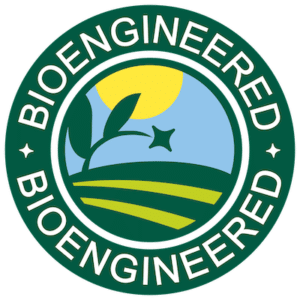
From a safety standpoint regarding our food supply nothing has changed, it’s just how foods containing genetically engineered (GE) or genetically modified organisms (GMOs) are labeled. For consumers, it changes nothing about the food we eat except the label and the intent of providing more transparency. Even though the term GMO will not entirely fade, we almost certainly can say, “move over GMO, bioengineered is the new label in town.”
The Meaning Behind the Words
Regardless of the term or word, there are always supporters and dissenters about the terminology. The term “bioengineered” has been viewed as the scientifically correct term by the scientific and agriculture community for years based on the specific breeding technique. However, the term GMO was embraced by consumer advocacy groups and ultimately used by the food industry. Some food advocacy and policy groups argue that the change of terms will create consumer confusion. Others contend the term GMO has already confused consumers given what it really means and how it’s been used to describe the modification of just a few foods (10 to be exact).
So is there a difference between the two terms? Technically, yes. Scientists maintain that essentially any food we eat has had its genes modified over the years — either from a traditional plant breeding process or through today’s sophisticated technology. The fruits and vegetables we eat today are not our forefathers’ versions! As background, here’s a brief primer on the four main methods of plant breeding or seed improvement:1
- Selective breeding, from which bananas, broccoli and citrus are produced, has been around for thousands of years.
- Hybridization/cross-breeding, from which seedless grapes and watermelons are created, has been used for over 200 years. This process also creates most of the apple varieties we enjoy today and other fruit hybrids like tangelos.
- Mutagenesis is the process which produces distinct colors and flavors like those of the Ruby Red grapefruit. This seed improvement process, stated in the 1920s, uses radiation and other physical or chemical alterations to produce random changes in plants, creating new color and flavor profiles.
- Transgenesis, the bioengineering or GMO seed improvement process, involves the addition of precise, specific genes or the silencing of existing genes to achieve traits like drought tolerance, disease resistance or non-browning, which are all beneficial to the survival of a crop, reduction of food waste or improved environmental impact.
Based on these definitions, the term bioengineered (BE) more accurately describes the foods with specific gene modifications for which the USDA rule is intended.
Finding the Bioengineered Label
First and foremost, the BE label will not appear on all foods. It’s only for those foods that are bioengineered or have ingredients from other bioengineered foods. Even though the prolific use of the non-GMO seal would make one think there are numerous GMO versions of the same item, the reality is quite the opposite. The rule specifically refers to any food intentionally containing genetic material derived from GMO alfalfa, canola, corn, cotton, papayas, potatoes, soybeans, squash, sugarbeets or Arctic™️ Apples.1
Like other laws, there are always nuances or “loopholes” depending on your viewpoint. Even though BE ingredients are used in clothing or gasoline, this law applies only to food and food products that contain genetic material. For example, whole food products like corn or soy-based products must bear the label, but highly processed items like corn syrup or soy sauce do not. These processed items do not contain the genetic material whether it’s GMO/BE or not. Also, meat and poultry products and food sold at restaurants are exempt.2

The Bottom Line
Here is some food for thought:
- Regardless of the term used, the safety or nutritional content of the food product has not changed. As USDA states, “Nothing in the disclosure requirements set out in this final rule conveys information about the health, safety, or environmental attributes of BE food as compared to non-BE counterparts. In fact, the regulatory oversight by USDA and other Federal Government agencies ensures that food produced through bioengineering meets all relevant Federal health, safety, and environmental standards.”3 The National Academy of Sciences verified the safety of bioengineered food in recent years.
- The law is administered by the USDA Agricultural Marketing Services (AMS), the same agency that oversees the USDA Organic programs. If safety of the products was of concern, the USDA Food Safety Inspection Service (FSIS) would be involved.
- The Non-GMO Project and the USDA Organic symbols will not go away. Both symbols verify that packaged food items with the symbols are without genetic modified traits.
- Implementation of this law will have financial ramifications for the food companies so who will bear the cost?
- The intent of the standardized label is to improve transparency for the consumer, but it won’t change the controversy that always surrounds this issue.
So bottom line, is this “much ado about nothing” or a step in the right direction? The answer lies within our own convictions, but at the end of day, bioengineered is here to stay.
References
1. “Here’s everything you need to know about USDA’s National Bioengineered Food Disclosure Standard,” GMO Answers by CropLife International. Accessed January 3, 2022.
2. Jessica Fu, “New ambiguous food label just dropped,” The Counter’s newsletter Thinly Sliced, January 4, 2022.
3. National Bioengineered Food Disclosure Standard, Federal Register, December 12, 2018. Accessed Jan 5, 2022.
Resources
“The USDA’s new labeling for genetically modified foods goes into effect Jan. 1. Here’s what you need to know.” Laura Reiley, The Washington Post, January 1, 2022.
“Congress Passes Legislation Mandating a National Bioengineered Food Disclosure Standard: Five Things You Need to Know,” July 21, 2016, Sidley Environmental Update.
